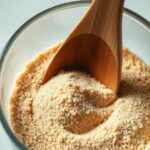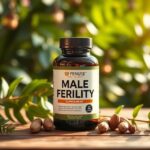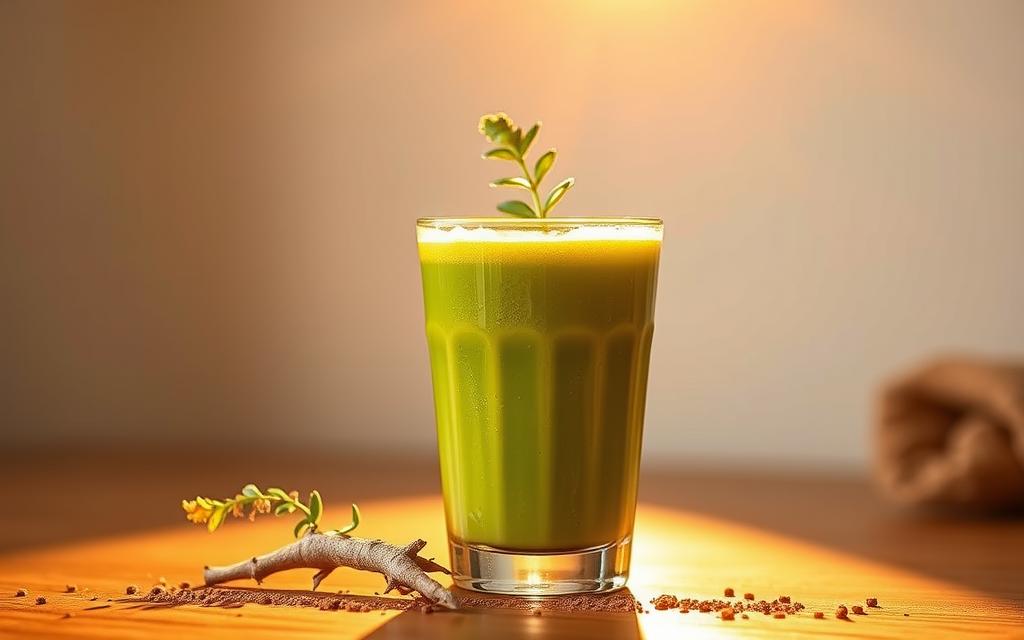Prebiotic Fiber Supplement: Prebiotic fiber foods

Your digestive system thrives on fuel it can’t actually digest. Specialized compounds in certain foods act like fertilizer for the trillions of microorganisms in your intestines. These unsung heroes work tirelessly to strengthen immunity, balance mood, and even regulate metabolism.
Research shows nearly 95% of Americans miss daily intake targets for these crucial nutrients. Women require 21-25 grams daily, while men need 30-38 grams. This gap leaves many struggling with digestive discomfort, energy slumps, and weakened defenses against modern stressors.
Not all plant-based nutrients function the same way. While traditional options support regularity, advanced varieties specifically feed your microbiome’s VIPs. This distinction creates a ripple effect across every system in your body, from brain function to inflammation control.
Key Takeaways
- Specialized plant compounds fuel beneficial gut bacteria
- 95% of Americans fall short of daily intake goals
- Gender-specific needs: 21-25g (women), 30-38g (men)
- Microbiome support impacts immunity and metabolism
- Advanced nutrition targets differ from basic options
- Gut balance influences whole-body wellness
- Top Rated Fertility Pills for Men – Get Pregnant Faster
- Swanson Premium Psyllium Husks: Fiber Supplement
Introduction to Prebiotic Fiber Supplements
Your intestinal ecosystem thrives on unique plant compounds that bypass digestion entirely. These invisible allies journey through your system untouched, reaching their final destination where they matter most – your colon’s microbial community.
Understanding Microbial Fuel Sources
Not all plant-based nutrients serve the same purpose. Regular dietary components support basic bodily functions, while specialized varieties act as targeted nourishment for your intestinal flora. This distinction determines whether you’re simply eating or strategically feeding your inner ecosystem.
| Feature | Microbial Fuel | Standard Nutrition |
|---|---|---|
| Digestion Process | Reaches colon intact | Broken down earlier |
| Primary Benefit | Feeds good bacteria | Supports regularity |
| Food Sources | Chicory root, garlic | Whole grains, veggies |
The Gut-Health Connection
When your microbial partners receive proper nourishment, they return the favor through multiple systems. Balanced flora helps regulate immune responses and influences metabolic processes. Research indicates these microscopic allies may even impact neurotransmitter production.
Modern diets often lack sufficient quantities of these crucial compounds. Strategic nutritional choices become essential for maintaining microbial diversity. This approach supports not just digestion but whole-body wellness through intricate gut-organ communication networks.
What Are Prebiotic Fibers and Their Health Benefits?
Imagine fueling an invisible workforce that shapes your entire well-being. Certain plant compounds slip through digestion untouched, arriving intact in your lower intestines. This unique delivery system nourishes microscopic allies that influence everything from nutrient absorption to disease resistance.

Gut Microbiome Support
Your intestinal flora transforms these undigested nutrients into powerful allies. Through bacterial fermentation, they produce short-chain fatty acids that energize colon cells. This process maintains the mucosal barrier while crowding out harmful organisms.
Consistent intake encourages microbial diversity critical for resilience. Studies show balanced ecosystems correlate with better stress response and nutrient utilization. Think of it as cultivating a thriving garden where only the strongest beneficial strains flourish.
Digestive and Overall Wellness
The ripple effects extend far beyond regular bowel movements. A well-fed microbiome communicates with immune cells through intricate signaling pathways. This cross-talk helps modulate inflammation and optimize metabolic functions.
Emerging research reveals connections between gut balance and mental clarity. By maintaining this internal partnership, you create a foundation for sustained vitality. Every meal becomes an opportunity to reinforce your body’s natural defense network.
How Prebiotic Fiber Supplements Support Digestion
Behind every efficient digestive system lies a well-fed microbiome working in harmony with your body. These specialized compounds act as targeted nourishment, helping maintain the delicate balance required for optimal function.

Mechanisms of Action
These supplements operate through a unique two-step process. First, they reach the colon intact, where beneficial bacteria ferment them into valuable compounds. This fermentation produces short-chain fatty acids that strengthen the gut lining and support metabolic functions.
Unlike harsh stimulants, they don’t force immediate reactions. Instead, they create an environment where natural digestive rhythms flourish. This gentle approach helps maintain balance without disrupting your body’s inherent wisdom.
The Role in Promoting Regularity
Consistent intake encourages predictable bowel patterns through physical and microbial actions. The compounds add gentle bulk to stool while improving intestinal motility. Over weeks, your system adapts to process nutrients more efficiently.
Some initial gas or bloating may occur as your microbiome adjusts. Gradually increasing intake and staying hydrated helps ease this transition. Most users report improved comfort within 2-3 weeks as their gut ecosystem stabilizes.
| Feature | Prebiotic Supplements | Laxatives |
|---|---|---|
| Primary Action | Feed beneficial bacteria | Stimulate bowel movement |
| Long-term Use | Safe and beneficial | Risk of dependency |
| Side Effects | Mild, temporary | Possible cramps |
Prebiotic Fiber Supplement Product Roundup
Modern wellness solutions now come in forms that fit seamlessly into busy lifestyles. Leading brands combine science with convenience to create nutritional aids that feel like treats rather than chores.

Featured Products and Their Key Ingredients
Nature Made offers two standout options for different preferences. Their chewable gummies provide 6g per serving with a fruity twist, while the unflavored powder mixes invisibly into drinks. Seed’s dual-capsule system pairs 24 probiotic strains with pomegranate-derived nutrients for comprehensive support.
| Product | Key Ingredients | Delivery Method | Special Features |
|---|---|---|---|
| Nature Made Gummies | Chicory root extract | Chewable | 6g per serving |
| Nature Made Powder | Inulin fiber | Drink mix | No added sugars |
| Seed Daily Synbiotic | Pomegranate extract + probiotics | Capsule-in-capsule | 53.6 billion AFUs |
Delivery Methods and Unique Formulas
Today’s product types cater to every routine. Those who dislike pills can choose tasty gummies or mixable powders. Advanced systems like Seed’s protective capsules ensure ingredients survive stomach acid.
Many companies now offer free shipping on subscriptions, making consistency easier. Whether you prioritize flavor, convenience, or scientific innovation, there’s a formula matching your needs. Always check labels for third-party testing and allergen info.
Comparing Different Prebiotic Fiber Products
Navigating the world of gut-supporting nutrients requires understanding their unique characteristics. Two main categories dominate the landscape: soluble and insoluble varieties. Each interacts differently with your body, offering distinct advantages for digestive harmony.

Variety in Fiber Types: Soluble vs. Insoluble
Soluble options dissolve in water, forming a gel-like substance that supports gradual nutrient absorption. This type accounts for 85% of consumer preferences due to its gentle action. Psyllium leads the market, chosen by 3 out of 4 users for its versatility.
Insoluble varieties remain intact through digestion, adding bulk to support regularity. Though less common in supplements, they play crucial roles in specific dietary plans. Both types work synergistically to create optimal conditions for microbial diversity.
| Feature | Soluble | Insoluble |
|---|---|---|
| Water Interaction | Forms gel | Remains intact |
| Primary Benefit | Nutrient absorption | Digestive motility |
| Common Sources | Psyllium, oats | Wheat bran, veggies |
Polycarbophil and methylcellulose offer alternative solutions for sensitive systems. These ingredients demonstrate how modern science tailors nutrients to individual needs. Always consider your body’s responses when selecting formulas.
Understanding these differences empowers smarter choices for long-term wellness. Pair this knowledge with professional guidance to maximize benefits while minimizing discomfort.
Exploring Natural Prebiotic Fiber Foods
Nature’s pantry holds hidden treasures that fuel your inner ecosystem. Common ingredients like bananas and oats contain specialized compounds that nurture beneficial gut bacteria. These everyday choices can transform meals into microbiome-boosting experiences while satisfying your taste buds.
Fruits, Vegetables, and Whole Grains
Certain plants pack a double punch of nutrients and gut-supporting properties. Asparagus contains inulin, a compound that feeds good bacteria while providing folate. Artichokes offer both soluble and insoluble varieties of dietary fiber, making them versatile for digestive health.
Whole grains like oats and barley deliver beta-glucan, a powerhouse nutrient. This soluble type helps maintain steady energy levels while supporting microbial balance. A single serving of cooked barley provides nearly 30% of daily dietary fiber needs.
| Food | Key Compound | Daily Value % |
|---|---|---|
| Bananas | Resistant starch | 12% |
| Garlic | Fructooligosaccharides | 18% |
| Oats | Beta-glucan | 25% |
Incorporating Gut-Nourishing Ingredients
Start mornings with oatmeal topped with sliced green bananas for resistant starch. Roast asparagus with olive oil and garlic for a flavorful side dish. Add cooked barley to soups or salads for extra texture and nutrients.
Snack on raw Jerusalem artichokes or blend them into dips. These small changes help create diverse meals that support digestive wellness. Over time, these habits become effortless ways to prioritize gut health through food.
Buying Tips for Prebiotic Fiber Supplements
Navigating the supplement aisle can feel overwhelming without clear guidance. Smart choices begin with understanding what separates premium products from mediocre options. Focus on three pillars: verified quality, transparent sourcing, and consumption practices that maximize benefits.
Quality and Ingredient Transparency
Trustworthy manufacturers provide detailed information about their production standards. Look for NSF or USP certifications on labels – these indicate third-party verification. Reputable companies openly share where they source ingredients and how they test for purity.
| Quality Marker | Trusted Brands | Budget Options |
|---|---|---|
| Third-Party Testing | 95% provide reports | 23% share data |
| Ingredient Source | Named farms/regions | “Proprietary blend” |
| GMP Certification | 89% compliant | 41% compliant |
Pair your routine with meals to enhance absorption and reduce discomfort. Always take capsules with 8 oz of water to support proper digestion. Start with half the recommended dose for 5-7 days to let your body adjust.
Subscription services often offer 15-20% savings with free shipping. Bulk purchases work well for households using multiple products. Check return policies – leading brands provide 90-day guarantees for risk-free trials.
Expert Opinions and Clinical Findings
Healthcare professionals emphasize personalized approaches to digestive wellness. Recent studies highlight how different nutritional strategies affect women’s long-term health outcomes. Let’s examine evidence-based guidance from leading experts.
Insights from Dietitians and Doctors
A 15-year Women’s Health Initiative study tracked 160,195 postmenopausal participants. Research revealed those using insoluble gut-supporting formulas faced 2.79 times higher colon-related risks compared to non-users. Psyllium-based options accounted for 87% of these cases.
| Fiber Type | User Group | Health Outcome |
|---|---|---|
| Insoluble | 3.7% of women | Increased risk |
| Soluble | Control group | Neutral effect |
| Combination | Under research | Promising results |
Dr. Mysore recommends high-quality formulas like Seed during antibiotic use or travel. These help maintain microbial balance when routines change. “Targeted nutrition supports beneficial bacteria without disrupting natural rhythms,” she notes.
Key considerations for women’s health:
- Choose soluble options during hormonal changes
- Consult providers before starting new regimens
- Monitor body responses for 3-4 weeks
Clinical data shows timing matters. Integrate gut-supporting formulas with meals for better absorption. Pair with probiotic-rich foods to enhance bacterial diversity naturally.
The Role of Soluble and Insoluble Fiber in Gut Health
Your gut thrives on a dynamic duo working in tandem. Soluble types dissolve into a gel-like substance, slowing digestion to enhance nutrient absorption. Insoluble varieties add bulk, keeping things moving smoothly through your system.
These partners support your microbiome in different ways. Soluble options feed beneficial bacteria that produce vital compounds. Insoluble forms act like nature’s broom, sweeping waste while maintaining intestinal structure.
Together, they create balance where it matters most. This teamwork strengthens gut lining integrity and regulates elimination patterns. Studies show combining both types improves microbial diversity better than single forms alone.
Smart dietary choices harness their combined power. Think oatmeal with berries for soluble support and roasted veggies for insoluble benefits. This approach nurtures your inner ecosystem while promoting whole-body wellness.
FAQ on Prebiotic Fiber Supplement
Q1. How do prebiotics differ from probiotics?
Ans: Prebiotics act as fuel for beneficial bacteria in your gut, while probiotics are live microorganisms that add to your microbiome. Together, they create a thriving environment for digestive harmony and overall vitality.
Q2. Can natural foods replace prebiotic supplements?
Ans: Absolutely! Foods like bananas, oats, and asparagus are rich in natural fibers that nourish your gut. Supplements simply offer a convenient boost for those seeking extra support in their daily routine.
Q3. What’s the difference between soluble and insoluble fibers?
Ans: Soluble fibers dissolve in water, forming a gel-like substance that supports healthy digestion. Insoluble fibers add bulk to stool, promoting regularity. Both play unique roles in maintaining a balanced digestive system.
Q4. How quickly can I expect results from these products?
Ans: Consistency is key. Many notice improvements in bowel regularity within a few weeks, but individual responses vary. Pairing supplements with a fiber-rich diet accelerates the journey to feeling your best.
Q5. Are there side effects when starting prebiotic-rich products?
Ans: Some may experience mild bloating as their gut adjusts. Gradually increasing intake and staying hydrated helps ease this transition, allowing your body to adapt smoothly.
Q6. What should I look for in a high-quality supplement?
Ans: Prioritize transparency. Seek options with minimal additives, clear ingredient lists, and third-party testing. Brands like Renew Life or Garden of Life emphasize purity and potency for optimal results.
Q7. Can these products help with irritable bowel syndrome (IBS)?
Ans: Studies suggest certain fibers, like partially hydrolyzed guar gum, may ease IBS symptoms. Always consult a healthcare provider to tailor choices to your unique needs and goals.
Q8. Why is ingredient sourcing important for gut health?
Ans: Clean, responsibly sourced ingredients reduce exposure to toxins and enhance nutrient absorption. Your gut deserves the best—opt for brands committed to quality from soil to shelf.












